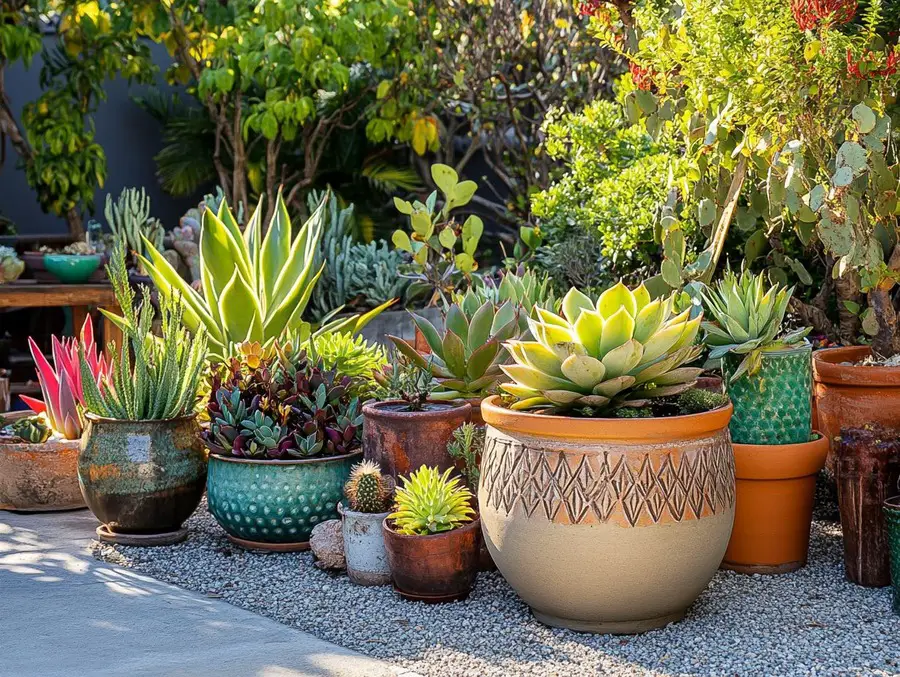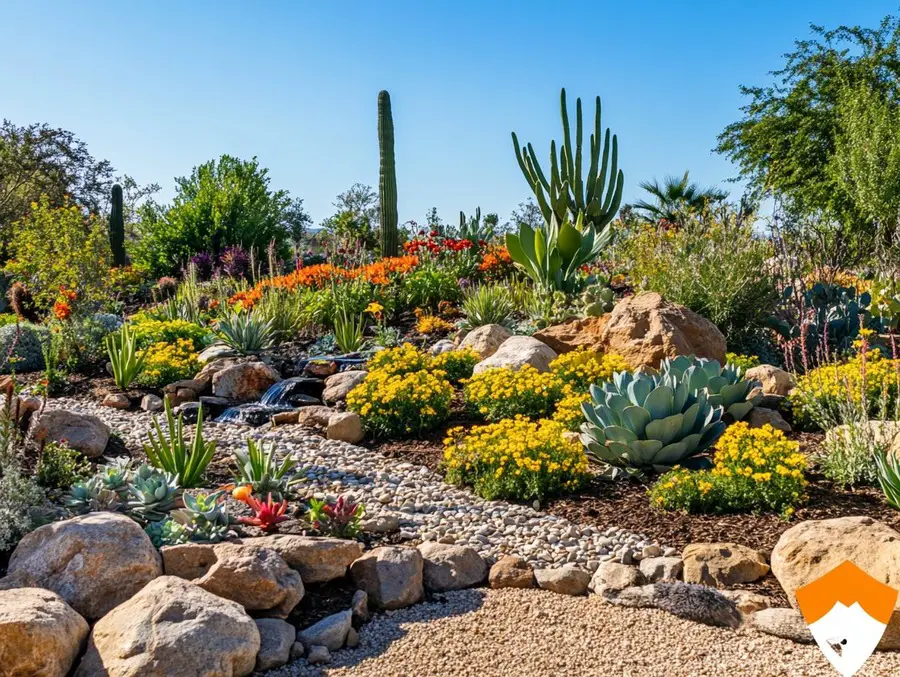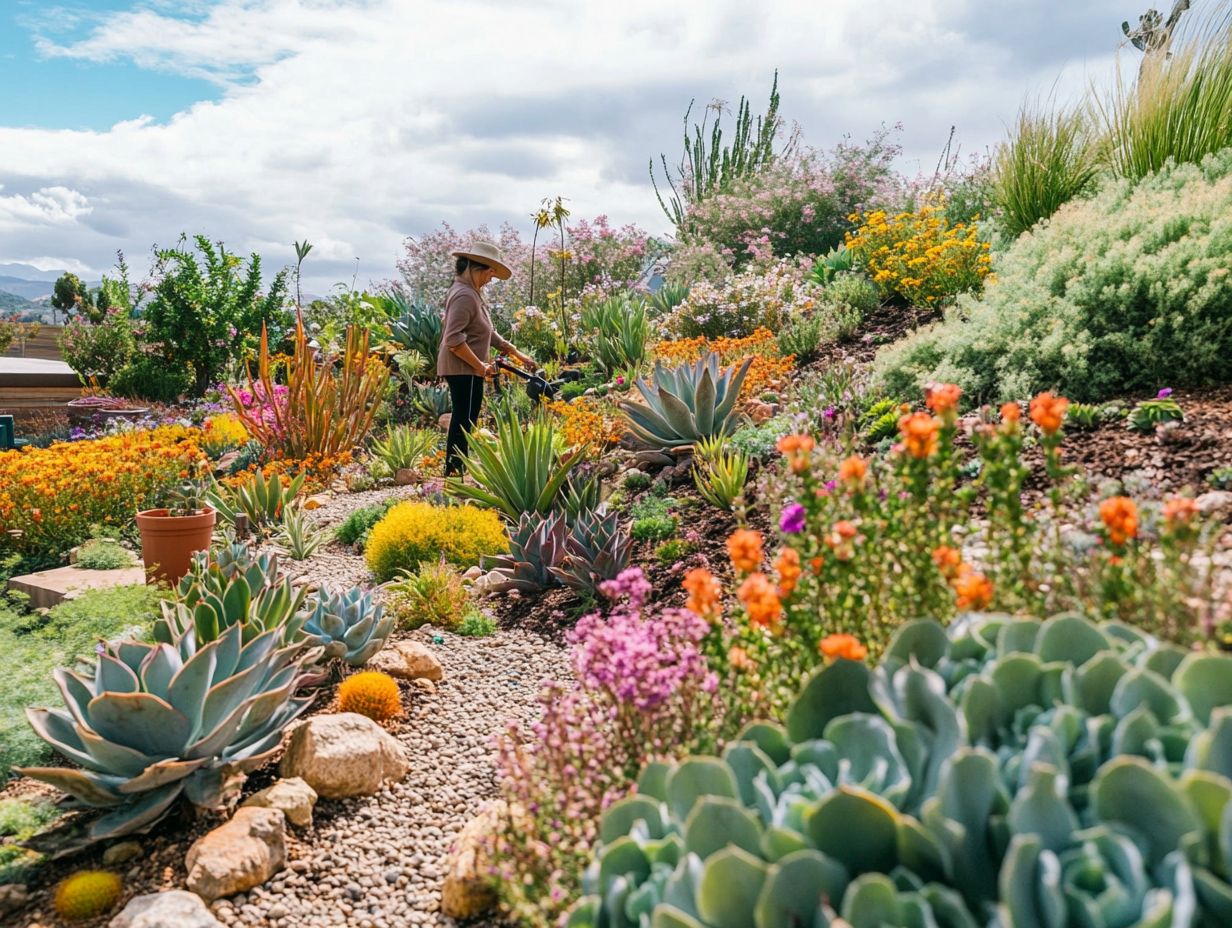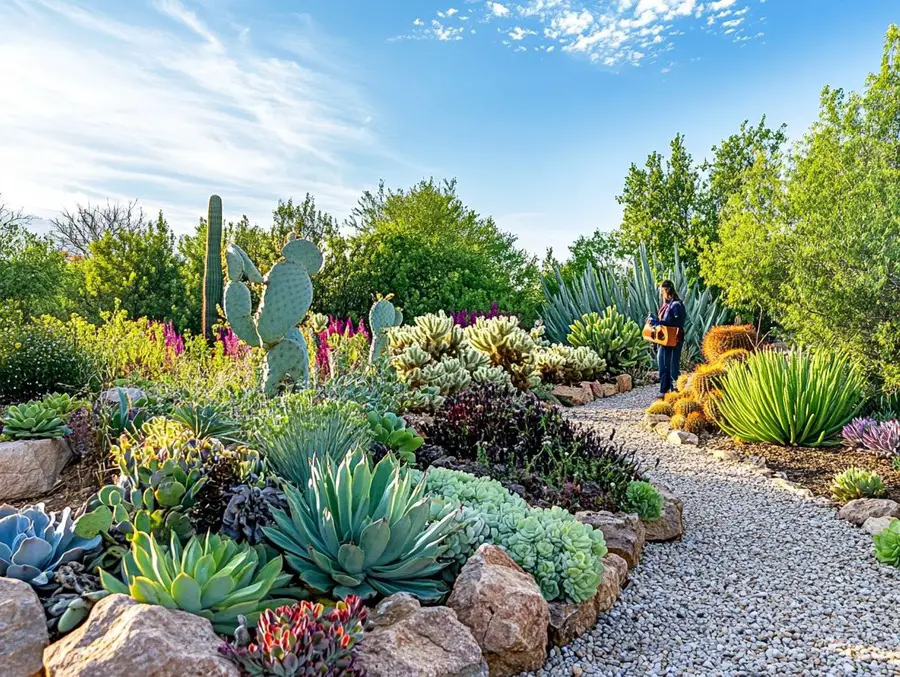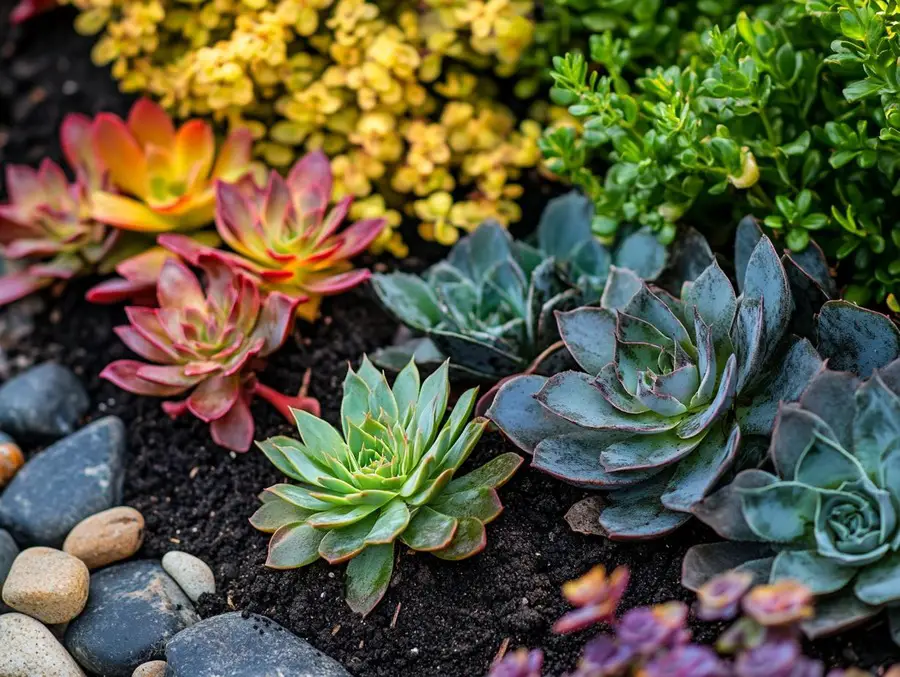We use affiliate links. If you purchase something using one of these links, we may receive compensation or commission.
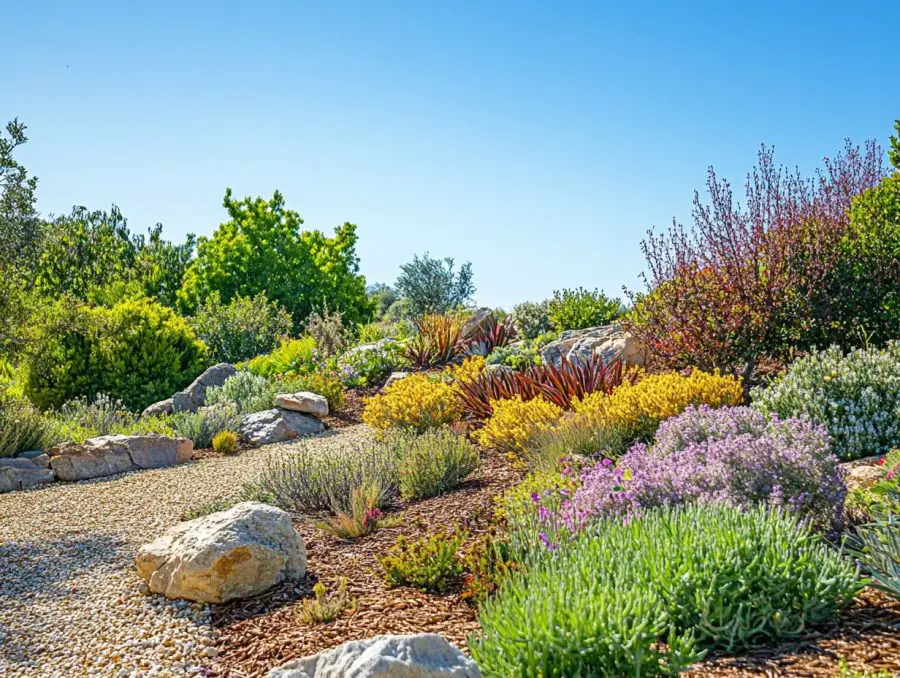
Learn how xeriscaping reduces water usage. This isn’t just a theory, it’s a proven way to save water without sacrificing a beautiful yard.
Traditional lawns soak up gallons of water daily, driving up bills and wasting resources.
By switching to drought-friendly plants, mulch, and smarter irrigation, you can cut your water use dramatically while keeping your outdoor space lush.
Xeriscaping Reduces Water Usage Key Takeaways
- Xeriscaping Reduces Water Usage by replacing grass with drought-tolerant plants.
- Use mulch to retain moisture, and install drip irrigation.
- These methods cut water waste while keeping gardens green.
- Collecting rainwater and designing for natural absorption also reduces the need for irrigation.
- Xeriscaping can save up to 60% more water than traditional yards.
How Xeriscaping Reduces Water Usage & Saves You Money
Water shortages are becoming a real problem, and keeping a green lawn takes more water than most people realize.
Xeriscaping offers a smarter way to garden by cutting water use dramatically.
With drought-resistant plants, mulch, and efficient watering methods, you can create a beautiful yard while saving water and lowering your utility bills.
The Water Crisis and the Need for Xeriscaping
Water conservation is no longer just a good idea, it’s a necessity.
Many areas face severe droughts, and traditional lawns require excessive watering to stay green.
This overuse strains local water supplies and drives up costs.
Xeriscaping provides a smart, sustainable way to cut back on water waste while maintaining a beautiful outdoor space.
Why Water Conservation Matters
Saving water isn’t just about lowering your bill, it’s about protecting natural resources.
Many regions experience seasonal droughts, making it harder to maintain a lush yard.
- Freshwater supplies are shrinking in many states.
- Water restrictions are becoming more common.
- Using less water helps prevent shortages in dry climates.
How Traditional Lawns Waste Water
A standard lawn drinks up thousands of gallons of water every year.
The constant need for irrigation, especially in hot climates, makes them unsustainable.
- Grass requires frequent watering to stay green.
- Most sprinkler systems waste water through runoff and evaporation.
- Fertilizers and chemicals used on lawns also pollute groundwater.
By making simple changes, like replacing grass with low-water plants, you can reduce waste and still enjoy a thriving yard.
How Xeriscaping Helps Conserve Water
Xeriscaping isn’t just about using less water, it’s about using it wisely.
By replacing thirsty lawns with drought-tolerant plants, adding mulch, and improving irrigation, you can keep your yard green without constant watering.
These small changes add up, helping you save thousands of gallons of water every year.
Replacing Lawns with Drought-Tolerant Plants
Traditional grass lawns are one of the biggest water guzzlers in a yard.
Swapping them out for drought-tolerant plants can drastically cut water usage while still keeping your space lush and colorful.
How Much Water You Save by Removing Grass
Grass needs frequent watering to survive, especially in dry climates.
By switching to xeriscape-friendly plants, you could reduce outdoor water use by up to 50%.
- A 1,000-square-foot lawn can use over 35,000 gallons of water per year.
- Swapping turf for drought-tolerant plants can cut water use by 50-75%.
- Native plants adapt to local conditions, requiring little to no extra watering.
- Drought-resistant plants may only need 10-30% of that amount.
- Once established, many xeric plants need little to no irrigation.
Best Xeriscape Plants for Minimal Irrigation
Instead of grass, consider these tough, low-water plants that thrive with little maintenance:
- Lavender – Fragrant, colorful, and attracts pollinators.
- Yarrow – A hardy flowering plant that handles dry conditions.
- Agave – A striking succulent that stores water in its leaves.
- Russian Sage – Adds height and texture with silvery leaves.
- Creeping Thyme – A ground cover that replaces grass with a soft, walkable carpet.
Replacing your lawn with these plants means less time watering and more time enjoying a beautiful, low-maintenance yard.
Using Mulch to Retain Soil Moisture
Mulch is a xeriscaping essential. It acts like a natural barrier, keeping moisture in the soil and protecting plants from heat.
Without mulch, the sun dries out the ground quickly, forcing you to water more often.
Mulch is one of the easiest ways to lock in moisture, keeping your soil from drying out too fast.
It helps regulate soil temperature, reduces evaporation, and even keeps weeds from stealing water from your plants.
How Mulch Reduces Evaporation
A layer of mulch acts like a protective blanket over your soil.
It keeps sunlight from hitting the surface directly, which slows down water loss.
Without mulch, soil dries out much faster, leading to more frequent watering.
- Mulch can reduce evaporation by up to 50%.
- Helps soil stay cool, which reduces plant stress.
- Prevents wind from stripping moisture from exposed dirt.
- Shields soil from direct sunlight, keeping it cool.
- Prevents runoff, so water soaks into the ground instead of washing away.
- Breaks down over time, improving soil health and water retention.
Best Mulch Choices for Water Conservation
Not all mulch is created equal. The right choice depends on your climate and garden style. Here are some of the best options for xeriscaping:
- Wood Chips or Bark – Long-lasting and improves soil over time.
- Shredded bark– Helps retain moisture while controlling weeds.
- Gravel or Rock Mulch – Ideal for hot, dry climates and doesn’t break down.
- Shredded Leaves or Straw – A free, natural option that enriches the soil.
- Compost – Enriches the soil while keeping it moist.
- Cocoa Hulls – Aesthetic and moisture-retaining, but keep away from pets.
Adding mulch around your plants can drastically reduce how often you need to water.
Plus, it keeps your garden looking tidy and well-maintained with minimal effort.
A good layer of mulch around your plants can reduce water loss by up to 50%!
How Xeriscaping Helps Conserve Water
Xeriscaping isn’t just about cutting back on water—it’s about using it smarter.
By replacing thirsty lawns, adding mulch, and installing better watering systems, you can keep a thriving yard while using a fraction of the water.
Here’s how these simple changes can make a big impact.
Replacing Lawns with Drought-Tolerant Plants
Lawns are one of the biggest water hogs in traditional yards.
Keeping grass green in dry climates can take thousands of gallons of water every year.
Replacing even part of your lawn with drought-tolerant plants can drastically cut down on irrigation needs.
How Much Water You Save by Removing Grass
- A 1,000-square-foot lawn can use up to 35,000 gallons of water per year.
- Swapping turf for drought-tolerant plants can cut water use by 50-75%.
- Native plants adapt to local conditions, requiring little to no extra watering.
Best Xeriscape Plants for Minimal Irrigation
If you want a low-maintenance yard, these plants thrive with little water:
- Lavender – Smells great and thrives in dry conditions.
- Agave – Stores water in its leaves, making it extremely drought-resistant.
- Russian Sage – A tough, flowering plant that attracts pollinators.
- Yarrow – Hardy, colorful, and spreads easily.
Switching out thirsty grass for these plants not only saves water but also reduces mowing and fertilizing needs.
H3: Implementing Efficient Irrigation Systems
Watering wisely makes all the difference when it comes to saving water.
Traditional sprinklers waste a lot of it through evaporation and runoff.
A better approach? Drip irrigation, which delivers water right where plants need it—at the roots.
Benefits of Drip Irrigation vs. Sprinklers
Switching from sprinklers to a drip system can cut water use by up to 50%. Here’s why:
- Less evaporation – Water drips directly into the soil, avoiding sun and wind exposure.
- No runoff – Water seeps in slowly, preventing waste.
- Better plant health – Roots get steady moisture without wetting the leaves, reducing disease.
While sprinklers spray water across a wide area, much of it never reaches the roots.
In contrast, drip irrigation delivers small, steady amounts exactly where needed.
How to Install a Simple Drip Irrigation System
Drip irrigation may sound complicated, but setting one up is easier than you’d think. Here’s how to do it:
- Lay out tubing – Arrange it near the base of plants, ensuring each gets coverage.
- Attach drip emitters – These small outlets control how much water flows to each plant.
- Connect to a water source – Attach the tubing to an outdoor faucet with a pressure regulator.
- Add a timer – Automate watering to keep it consistent without waste.
With a simple setup, you can drastically reduce water usage and keep plants thriving—even in hot, dry climates.
Designing for Natural Rainwater Collection
Instead of letting rainwater run off your property, xeriscaping lets you capture and use it where it’s needed. With the right design, you can store rainwater and guide it to thirsty plants.
Swales and Berms for Water Absorption
Swales are shallow trenches that collect rainwater and let it soak into the soil, while berms are raised areas that help direct water where it’s needed. Together, they:
- Slow down water runoff, so more soaks into the ground.
- Prevent erosion, especially in sloped areas.
- Reduce the need for extra irrigation after rain.
Placing swales and berms strategically around your yard ensures plants get the most from every drop of rain.
Using Rain Barrels to Store Water
Rain barrels let you save and store water for dry periods. Here’s why they’re useful:
- Collect free water instead of using municipal supplies.
- Reduce stormwater runoff, preventing erosion.
- Provide backup water for plants during droughts.
Setting up a rain barrel is simple: Place one under a downspout, add a filter to keep out debris, and use a hose attachment for easy access.
The Long-Term Impact of Xeriscaping on Water Usage
Xeriscaping doesn’t just save water in the short term—it has lasting benefits that grow over time.
By reducing the need for constant irrigation, improving soil health, and making better use of natural rainfall, you’ll see ongoing savings on your water bill while keeping your yard healthy and thriving.
Water Savings Over Time
The longer you stick with xeriscaping, the more water you save. Unlike traditional lawns that need frequent watering, xeriscaped yards become more self-sufficient as they mature.
How Much Water Can You Save?
- Switching from a grass lawn to drought-tolerant plants can cut water use by 50-75%.
- A properly designed xeriscape can save up to 120 gallons of water per day compared to a traditional lawn.
- Over five years, that’s more than 200,000 gallons saved for an average-sized yard!
The key is that xeriscape plants develop deeper roots, which help them access water stored deeper in the soil.
This makes them more resistant to drought conditions and reduces the need for extra watering.
How Xeriscaping Can Be Adapted in Different Climates
Xeriscaping isn’t just for desert areas. It works in almost any climate by selecting the right plants and designing for local weather conditions.
Adapting Xeriscaping to Various Climates
- Arid regions – Use succulents, gravel, and drip irrigation for water efficiency.
- Temperate climates – Choose native perennials that need little maintenance.
- Humid areas – Focus on well-draining soil and ground covers to prevent overwatering.
Even in places with seasonal rainfall, xeriscaping ensures you use every drop efficiently. With proper planning, it’s a long-term solution for reducing water use—no matter where you live.
FAQs: Xeriscaping and Water Conservation
Xeriscaping is a great way to cut down on water use, but you might have some questions before getting started. Whether you’re wondering how much water you can actually save or if xeriscaping works for small spaces, we’ve got answers. Here are some common questions about how xeriscaping helps conserve water.
Q. How much water can xeriscaping save?
A. Xeriscaping can reduce outdoor water use by up to 50–75% compared to traditional lawns. Since drought-tolerant plants require less irrigation and mulch helps retain moisture, you’ll see a noticeable drop in your water bill over time. The exact savings depend on your climate and plant choices.
Q. Is xeriscaping worth it for small gardens?
A. Absolutely! Even in small spaces, xeriscaping can make a difference. By replacing grass with drought-resistant plants and using mulch, you’ll minimize water waste while keeping your yard beautiful. Plus, small gardens are easier to maintain with efficient watering methods like drip irrigation or rain barrels.
Q. What are the best plants for a water-efficient xeriscape?
A. Some of the best options include succulents, lavender, Russian sage, yarrow, and ornamental grasses. Native plants also work well since they’re already adapted to your region’s rainfall. Choosing the right plants means less watering and lower maintenance.
Q. Does xeriscaping require a lot of upkeep?
A. Not at all! Once established, xeriscaped yards need far less maintenance than traditional lawns. Occasional weeding, seasonal pruning, and adjusting your watering schedule during extreme heat are the main tasks. The use of mulch and ground covers also helps reduce upkeep.
Q. Can I still have flowers in a xeriscape garden?
A. Yes! Many drought-tolerant plants bloom beautifully while requiring little water. Options like blanket flower, coneflower, and ice plant add color without increasing water usage. You can also plant flowering herbs like thyme or rosemary for a mix of beauty and function.
Q. What’s the best way to water a xeriscape garden?
A. Drip irrigation is the most efficient method since it delivers water directly to plant roots, reducing waste. Soaker hoses and rainwater collection systems are also great options. Watering early in the morning or late in the evening helps prevent evaporation.
If you’re thinking about making the switch to xeriscaping, these water-saving techniques can make a huge difference. It’s an easy way to create a low-maintenance yard while being mindful of water conservation!
Xeriscape Garden Design & Layout: Easy Water-Wise Beauty
Best Plants for Xeriscape Gardens: Hardy & Beautiful
Xeriscape Gardening Techniques: Easy Low-Water Tips
Xeriscape Garden Styles: Easy Low-Maintenance Options
What is xeriscaping? A beginner’s guide to drought-tolerant landscaping
Related Content
Visit my Amazon Influencer Page for videos and gardening products Grow Your Own Garden

